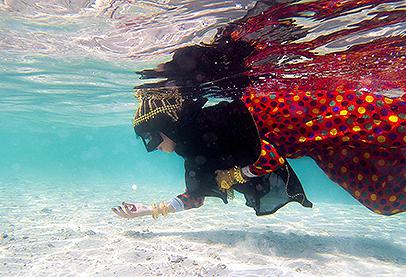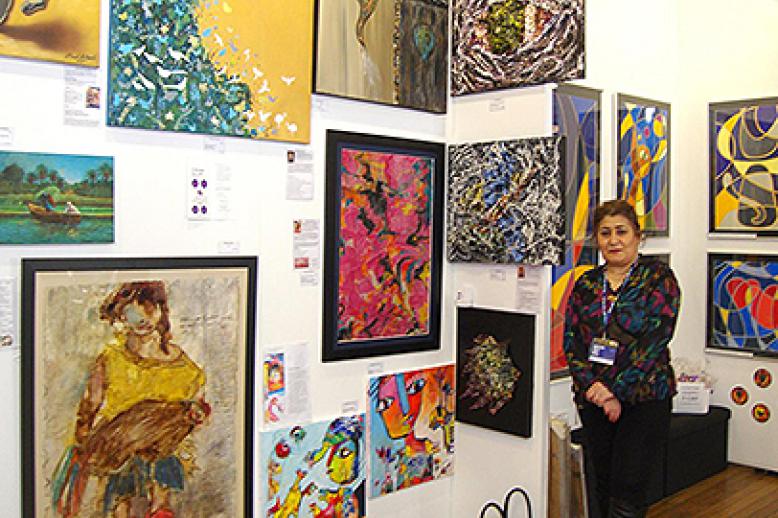Arab women artists in diaspora focus on identity and loss

Preoccupation with identity and loss of it are pivotal in the works of seven emerging Arab women artists living in Europe, North America and the Middle East, on show at East London’s Rich Mix Gallery.
“Perpetual Movement,” which runs through March 25, features Nadia Elkalaawy and Nadia Gohar from Egypt, Najd Al Taher from Kuwait, Araz Farra from Syria, Yumna al-Arashi and Thana Faroq from Yemen and the UAE’s Shaikha Fahad al-Ketbi.
Arab Women Artists Now (AWAN), which has been organising an annual exhibition of the work of women artists in the Arab world for four years, said “Perpetual Movement” considers the relationship between migration and memory in connection to the Arab world and diaspora.
“How does your memory of a place change once you have left? What happens if you are ethnically associated with a location but have never even been there? Movement can be both positive and negative, there are many reasons why it takes place but it is always happening,” AWAN stated.
Exhibition curator Lizzy Vartanian Collier explained that the works were selected to reflect the concept of movement and memory. “I chose to work with artists who each commented on something different, shed light on individual viewpoints and I wanted to reflect my own experience as well,” said Collier, a Lebanese-Syrian born and brought up in London.
Faroq’s black-and-white photographs present haunting images showing the agony of migration and exile. The three photos of a woman’s face titled “Invisible” suggest a loss of identity. “Life on Hold” pictures a woman sitting forlorn on a bed gazing out of the window and a man looking from a window in a bare concrete building, perhaps a prison.
A small document titled “The Passport” in a maroon cover is also on display. Inside are the photos and stories of people who have had issues with movement. An outline of the countries they came from on transparent tracing paper accompanies each story.
“The project explores the experiences of people who are hampered by their passports,” Faroq said. “It is about those who are banned from entering countries, the asylum seekers and stateless individuals who cross oceans and lands to obtain a passport that will guarantee them a higher value in life. There are reflections on personal moments, handwritten testimonies that capture the hopes, fears, dreams and struggle that are fostered by the restrictions of movement.”
Gohar also explores the restrictions imposed by passports in her work “Passport Photos: Do’s and Don’ts.” She features 25 passport-sized photos modelled on the photos one must present for a visa and explores issues of identity politics.
Collier pointed out that there are “works on display that celebrate the past and bring it into a modern context.”
“Yumna al-Arashi’s portraits of the last tattooed women from North Africa celebrate a tradition that is being lost. Similarly, Shaikha al-Ketbi’s photograph of ‘Ghaya,’ diving for a pearl in a traditional bridal costume brings pearl diving and marriage traditions into a modern context,” she said.
Farra’s short film combines surreal images with the voice of an Armenian who has lived in Aleppo all his life. “Which culture do I belong to?” he asks eager to portray the city he loves in a positive light. “Despite the hunger and the destruction the people of Aleppo still welcome foreigners,” he says.
Elkalaawy narrates the story of living between two cultures, Egyptian and British. Her acrylic-on-cotton “December Child” features an oyster card, old and new family photos and an embroidered table mat from the Middle East.
There is a sense of melancholy in the work of Arab women artists in the diaspora. “It is natural to address what we know and being in the diaspora can be a difficult position,” Collier said. “Gohar’s “Mobile” combines elements of an Egyptian and Canadian identity; it is fragile and disparate in parts but by fusing together two cultures, it celebrates them both, showing neither as more dominant than the other.”
Collier said the challenge of being an Arab woman artist in the diaspora was being disconnected from home.
“It often means that the artists’ work is always read as a political comment, even when that is not the case. There are advantages too. This separation and distance often offers the chance to reflect on the culture, traditions and politics of a homeland.
“It also seems to be the case that this very disconnection is what can cause people in the diaspora to become so interested and fascinated by the place they have left.”
This article was originally published in The Arab Weekly.


